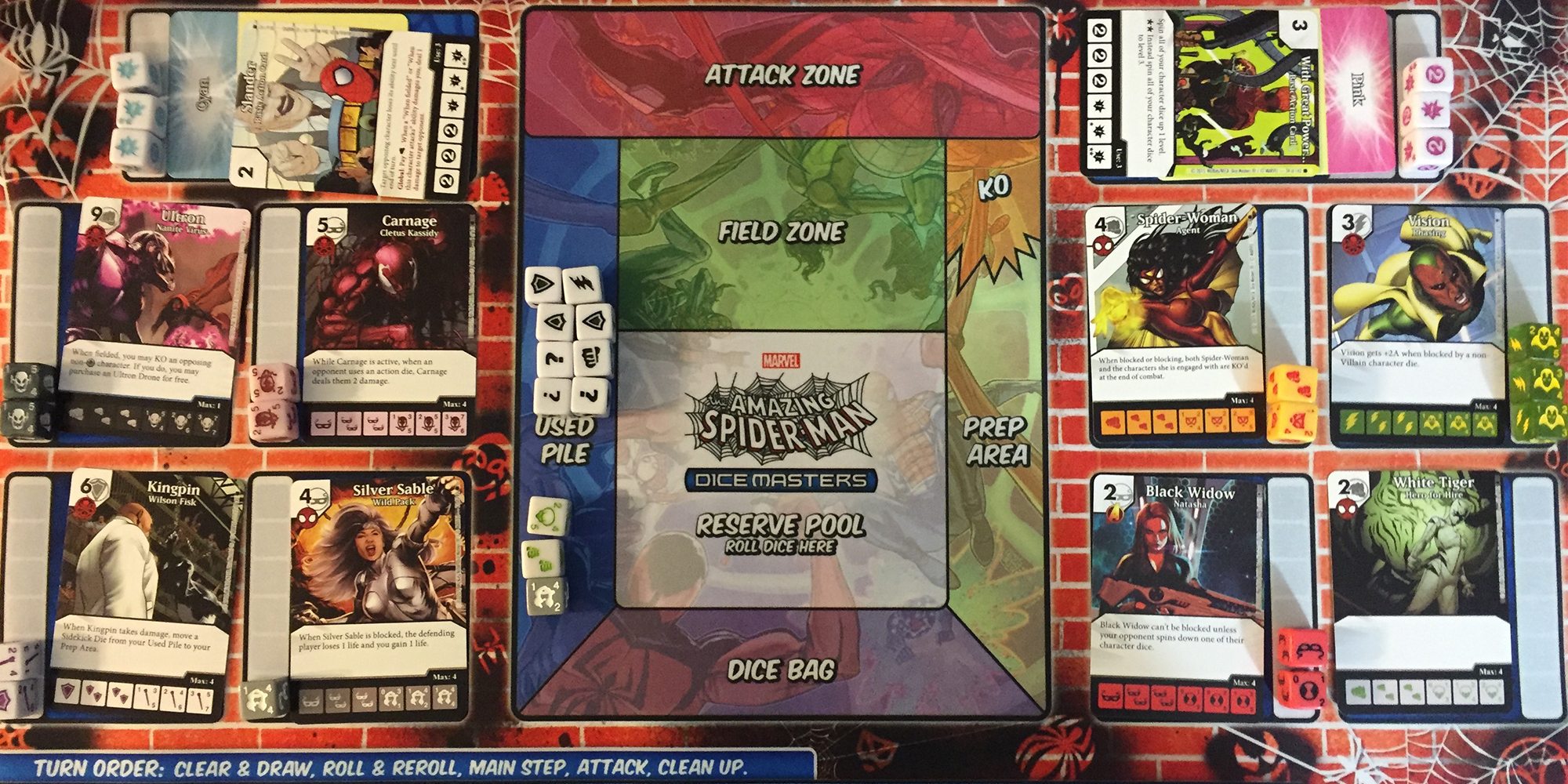Pocket Paragons is a quick, portable 2-player duel.
What Is Pocket Paragons?
Pocket Paragons is a battling card game for 2 players and takes about 3 to 15 minutes to play. There isn’t an official age recommendation listed; the core rules are pretty simple but the trick is figuring out how to use each character well. I was able to teach my 7-year-old to play; I would guess it’s the sort of game that would typically listed as 10 and up. It’s currently seeking funding on Kickstarter, with a pledge level of $20 for a copy of the game, or $80 for the “all-in” version that includes all 4 boxes and a playmat.
*Update (6/13/21): Pocket Paragons has been manufactured, and pre-orders are now open until it arrives in warehouses, at the same $20 price. (Once pre-orders close, the prices is expected to be $25.)
Pocket Paragons was designed by Brian McKay and published by Solis Game Studio.
New to Kickstarter? Check out our crowdfunding primer.

Pocket Paragons Components
Note: My review is based on a prototype copy, so it is subject to change and may not reflect final component quality. There may be additional components added via stretch goals.
There are 4 different sets of Pocket Paragons, and each one includes:
- 6 characters: 8 cards each
- 2 Dials (one per player, tracking HP and Energy.)
There’s also an optional playmat.
Now, the box itself doesn’t look like it’ll fit in your pocket (at least from the Kickstarter update photos): it’ll hold all six characters, plus the cardboard dials, even sleeved. However, that’s still a fairly compact game overall.

Each character consists of 8 cards. One is a character card that gives you a little information about that character’s abilities and overall strategy, along with a complexity level. The other 7 cards are ones that you will use for combat, and although each character has the same 7 actions (represented by colored icons), the specifics of those actions vary from character to character. For instance, everyone has a “Rest” action that lets you pick up your used cards and gain an energy, but some characters have additional effects when they play “Rest.” I do wish that there was

Some of the sets feature characters from other games: the combining robots of A.E.G.I.S., the time travelers from Temporal Odyssey, and even the elemental warriors from the videogame Rivals of Aether. The character illustrations vary in style because they come from these different games, but the battle cards themselves primarily use the common icons so there’s some consistency across the decks.
How to Play Pocket Paragons
You can download a draft of the rulebook here.
The Goal
The goal of the game is to defeat your enemy by reducing them to 0 health.
Setup
Each player chooses a character deck. Put your character card and your Ultimate ability card on the table in front of you, and the rest of the cards in your hand. Each player takes a dial and sets their HP to 10 and Energy to 0.
Gameplay
During each turn, each player chooses a card from their hand to play face-down, and then both cards are revealed simultaneously. Cards have a variety of effects: a large number means that you do that much damage to your opponent, reducing their HP. Some cards can exhaust (discard) other cards, or even banish them (removing them from the game).
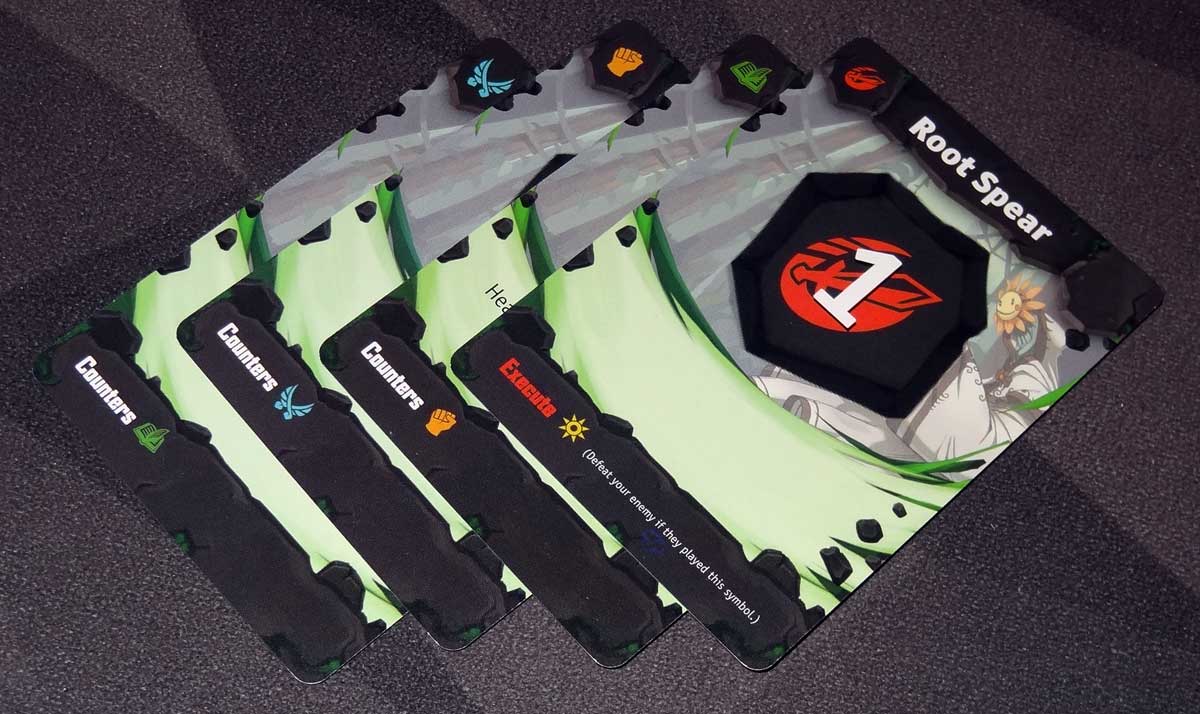
Many of the cards also counter specific moves, listed at the bottom of the card. If your opponent played the action shown as “counters” on your card, then you gain an energy, and their card does not take effect. The most powerful counter in the game is “Execute,” which happens if you play your weapon card and your opponent plays their rest card—you immediately defeat them regardless of their HP.
Once the cards are resolved, they are discarded. To get your cards back, you must play your “Rest” card to pick up all of your discarded cards and put them back into your hand.

Each player also has an ultimate ability, which comes into play once you have hit the required energy threshold (shown on the card). Some characters have passive ultimates: as soon as you have enough energy, that ability is in play for the rest of the battle. Others have ability ultimates: when you have enough energy, you spend it and put the card in your hand, where it can be played just like any other card. While it’s in your hand, you can’t earn energy, and once played you must earn energy to get the card back again.
Game End
The game ends when one player is out of health (or is executed); the other player wins. If both players run out of HP on the same turn, the player who has taken less damage wins. If that’s still a tie, continue playing until one player has taken more damage.
Tournament Play
For a deeper game, you can play tournament mode. Each player chooses 3 characters to play. You decide which order to use the characters, and play one at a time.
When your character is eliminated, you bring in the next character at full health, but the new character also inherits one ability from the defeated character. Choose one action card that isn’t marked “forbidden” and add it to your hand, replacing the same icon from the new character’s hand of cards. When you bring in your third character, you carry over the first card inherited and also inherit a card from the second character.
To win, you must defeat all three of your opponent’s characters.
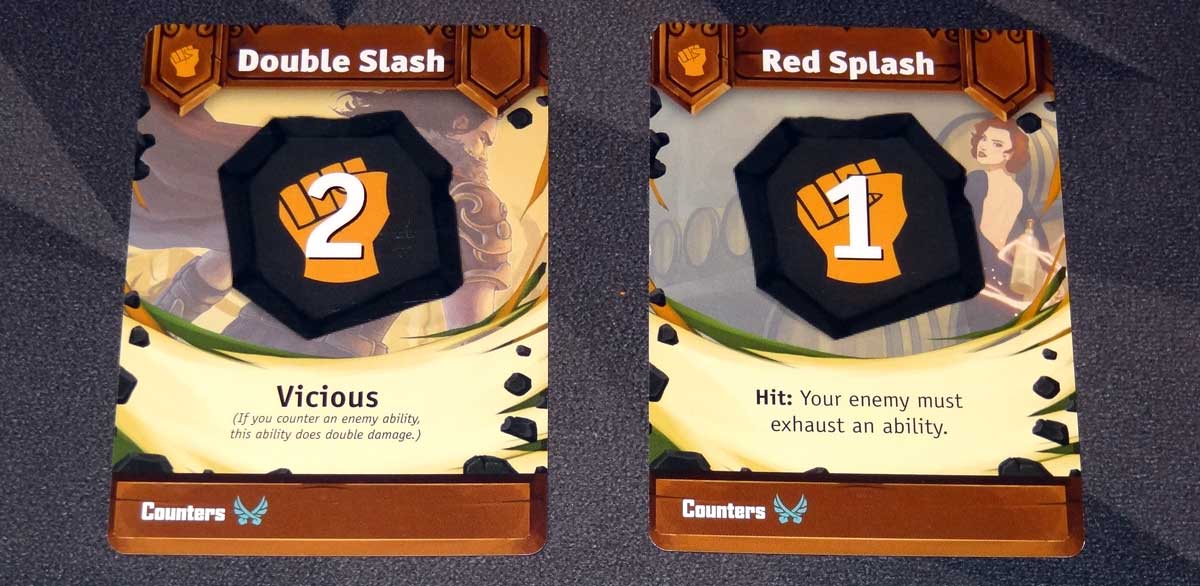
Why You Should Play Pocket Paragons
Pocket Paragons is built on a core of rock-paper-scissors, but plays around with it in a neat way. For instance, the strength (orange fist) action always counters dexterity (blue wings), which always counter intelligence (green book), regardless of which character you’re using. But each character’s strength action is slightly different. Zane, the Elder, does 2 damage, which doubles if your opponent plays their dexterity. Christina, the Sommelier, only does 1 damage, but if it lands, her opponent has to exhaust an ability.
Each character’s cards have a synergy for you to figure out. Poppet, one of the robot pilots from the A.E.G.I.S. world, can deal extra damage to herself in order to trigger various effects against her enemy. If she can survive long enough (or counter) to gain 2 energy, she can get those effects without hurting herself. Mr. F, the Awakened, is a flower-person who gets a boosted action each time he rests, and his ultimate lets him heal when he rests. But, of course, resting a lot puts you at risk of execution, so your rests need to be well-timed.
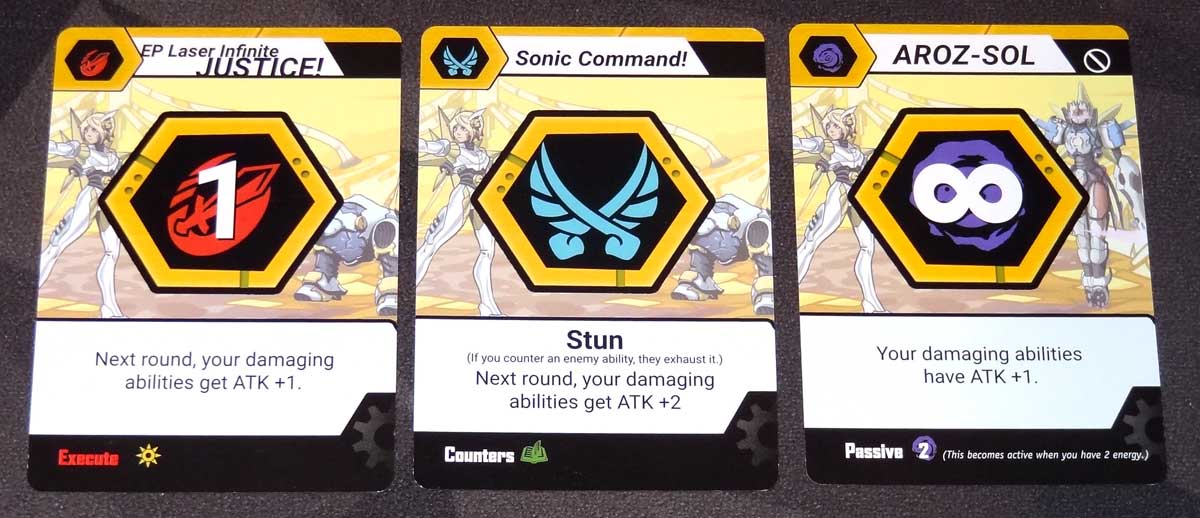
As with rock-paper-scissors, your hope in Pocket Paragons is to choose an action that counters your opponent’s, because it cancels out their action. Unlike rock-paper-scissors (or the variants with more than 3 options), there are many pairings in which neither counters the other, so they both take effect. Another difference is that actions you’ve played typically can’t be chosen again until you take a rest action, which means your options begin to dwindle. Do you rest when you’ve only exhausted a couple of cards, because your opponent will be less likely to attempt to execute? Or do you wait so that your rest action can get more cards back at once, at the risk of making it more obvious that you’re about to rest?
Although each character only has 7 actions, when you’re learning the game, that’s enough to keep track of that you’re less likely to have a good handle on what your opponent is capable of. You may be able to start figuring out some tactics for how to use your character, but it’s tricky to learn that and figure out what your opponent is up to, aside from just knowing the general ability types.
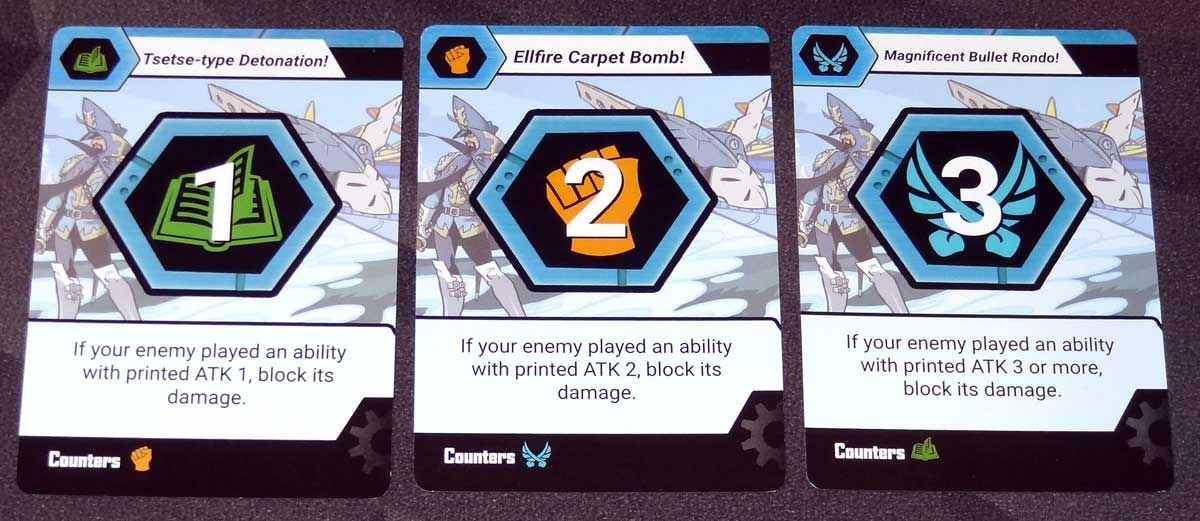
Playing tournament mode builds on that complexity—which action do you carry over to your next character? Which teams will provide a good synergy, and what order do you use your characters? Fortunately, each box provides suggested 3-vs-3 teams to use, but once you’re familiar with the game you can draft teams, especially if you have more than one box. I haven’t played enough yet to know the characters that well, but I can tell that it’s definitely a game that rewards repeated play to build up expertise.
I’m typically not bad at games involving predicting the other player. I was decent at Yomi, another two-player fighting card game, often figuring out the other player’s move so I could play a counter to it. But my first couple games against my 7-year-old, I got executed! In one game, I had gotten her down to nearly 0 HP, but then rested to get some cards back when she chose her weapon card. In another, she took me out within a few turns because I decided to rest early while she still had lots of options besides her weapon. Looks like I’ll need a bit more practice.
What I like about Pocket Paragons is the way that it boils down the two-player duel to a small, compact core, but with a few tricks up its sleeve. It’s not as complex as some of the other fighting games I’ve played, which may be a plus or a minus depending on your tastes, but each individual duel can be played very quickly and there’s basically no setup or cleanup time involved (except for selecting characters in tournament mode). If you like head-to-head combat games and you’re looking for one that has trimmed the fat, Pocket Paragons could be that lean fighting machine for you.
For more information or to make a pledge, visit the Pocket Paragons Kickstarter page!
Click here to see all our tabletop game reviews.
![]() To subscribe to GeekDad’s tabletop gaming coverage, please copy this link and add it to your RSS reader.
To subscribe to GeekDad’s tabletop gaming coverage, please copy this link and add it to your RSS reader.
Disclosure: GeekDad received a prototype of this game for review purposes.



